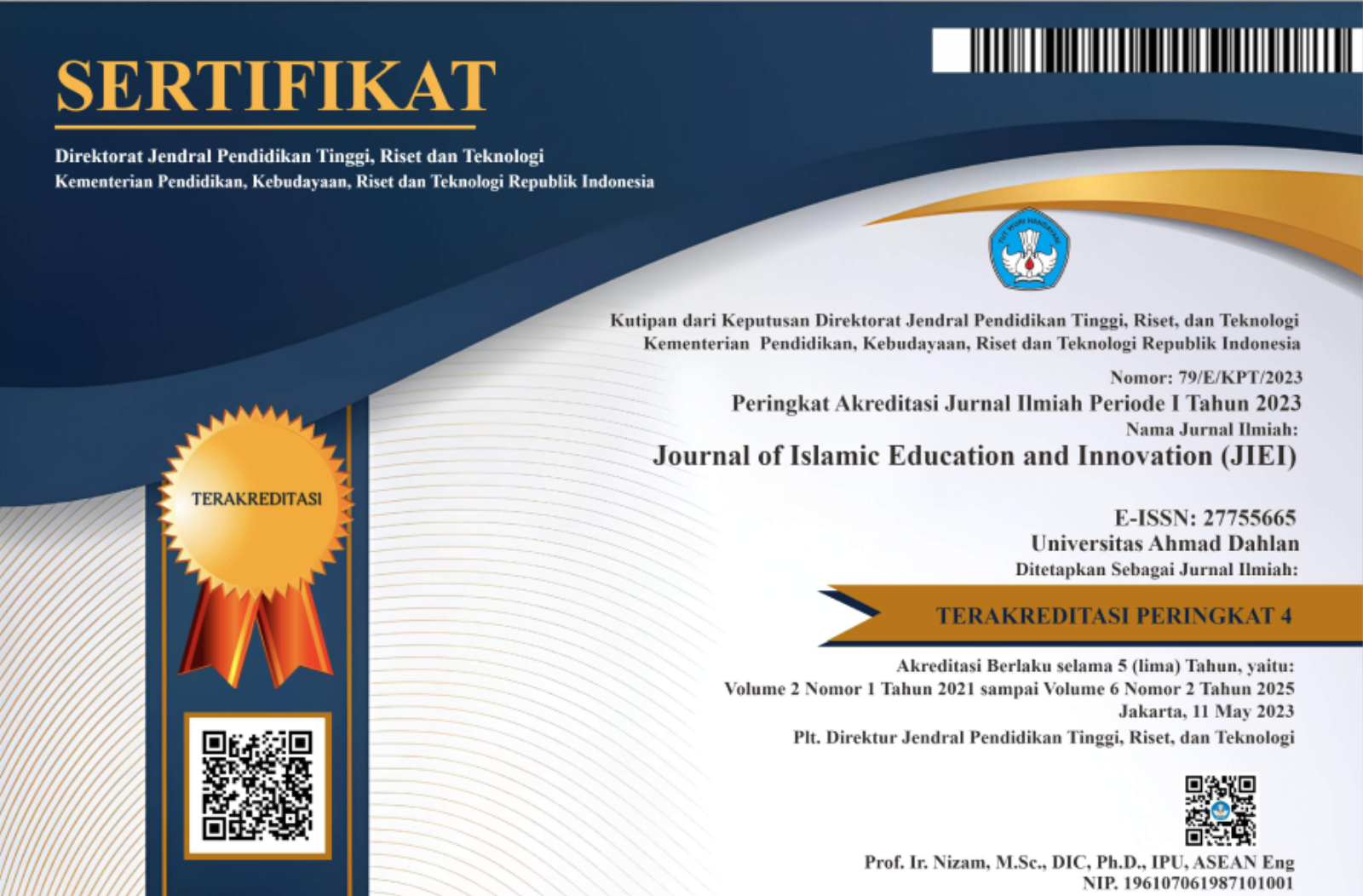Improved the ability to read the Quran for slow learner students in Yogyakarta: Single case research approach
DOI:
https://doi.org/10.26555/jiei.v2i1.1476Keywords:
Ability to read Al-Quran, Slow learner, Makharijul huruf, Tajwid, TartilAbstract
This study aims to improve the ability of slow learner students in reading the Quran . This type of research is a single case or single-case research with the ABABA intervention model. The research subjects were student at Muhammadiyah Junior High School Kulonprogo Yogyakarta. The sampling technique used purposive sampling. The data were collected using an assessment sheet instrument based on practical tests, observation sheets, and interview protocols. The assessment data were analyzed using descriptive statistics in the form of scoring based on the results of the test or treatment given based on each stage. The enhancement of the subject's ability was carried out by the AIR (Auditory Intellectually Repetition) method which is has the banaficial category because in a short period it could give results even though it was not optimal. The AIR method itself is a learning model with assignments that emphasize understanding listening to the material with a practice that is carried out repeatedly to gain deep understanding. While the results of observations and interviews are described in a narrative. The results of the study concluded that there was an increase in the students' ability to read the Quran according to the observed aspects, namely the increase in the ability of the Makhorijul Huruf, Tawjid, and Tartil after attending the training. The ability of the subject's Makhorijul Huruf increased 66.6 % than before the intervention, they are from 30 to 50 as result. Tajwid ability increased 33.3 % from 30 to 40 as result, and Tartil ability increased by 14.28 % from 35 to 40 as resultr, and Tartib experienced an increase of 100 % from 25 to 50. These results indicate the increase in students' ability to read the Quran in the quite good category.
References
Jakarta: Logos of Science discourse, 2003.
[2] S. Syaiful, Concepts, and Meanings of Learning. Bandung: ALfabeta, 2010.
[3] R. Law, Regarding the National Education System. Jakarta: Sinar Grafika, 2006.
[4] Mumpuniarti, Mumpuniarti, "Slow Learner Children's Education." J. HEALTH SCIENCE.
AISYAH, vol. 1, 2016.
[5] M. Syah, Islamic Psychology with New Education. Bandung: PT. Teen Rosdakarya, 2008.
[6] D. D. Ratri, Psychology of Children with Special Needs. Yogyakarta: PSikosain, 2016.
[7] L. Maftuhatin, "Evaluation of Learning for Children with Special Needs (ABK) in Inclusive Classes at SD Plus Darul' Ulum Jombang, "J. Stud. Islam Univ. Pesantren Tinggi Darul 'Ulum Jombang, vol. 6, 2014.
[8] D. Griffin, Slow learners: A break in the circle - Practical guide for teachers in secondary schools. London: The Woburn Press, 2005.
[9] Moskowitz M., "Teaching the Slow Learner Author (s): Myron Moskowitz Published by The University of Chicago Press Stable URL: http://www.jstor.org/stable/1082853," The Unversity of Chicago Journals, vol. 56, no. 8, p. 476–483, 1948.
[10] B. Baharudin, Developmental Psychology Education. Yogyakarta: Ar-Ruzz Media, 2012.
[11] M. Muhaimin, Islamic Education Paradigm. Bandung: PT. Teen Rosdakarya, 2012.
[12] Ash Shabuni. Moh Ali, Rawai'ul Bayan (Terj.), Tafsir Ayat al-Ahkam al-Quran. Surabaya: Bina Islam, 1987.
[13] A. Mustafa Al Maraghi, Tafsir Al Maraghi, 3 ed.
[14] A. Humam, How to Learn to Read the Qur'an. Jakarta, 2000.
[15] G. Singh, "Effectiveness of individualized education programs for slow learners.," Indian J. Pediatr., Vol. 73, no. 11, p. 135–137, 2006.
[16] Sumarni, Sugiarto, and Sunarmi, "Implementation of Auditory Intellectually Repetition (AIR) Learning on Critical Thinking Abilities and Mathematical Disposition of Students in Cube and Beam Materials," Unnes J. Math. Educ., Vol. 5, 2016.
[17] R. H. Horner and S. L. Odom, "Designs: Logic and Options," p. 27–51, 2014.
[18] D. Martens, Research and Evaluation in education and psychology 4th. United States: Sage Publications, 2015.
[19] T. R. Kratochwill et al., Single-case designs technical documentation. 2010.
[20] T. R. Kratochwill et al., "Single-case intervention research design standards," 2013.
[21] B. Nurgiyantoro, G. Gunawan, and M. Marzuki, Applied Statistics for Social Sciences Research. Yogyakarta: Gadjah Mada University Press, 2017.
Downloads
Additional Files
Published
Versions
- 2021-06-30 (2)
- 2021-04-21 (1)
Issue
Section
License
License and Copyright Agreement
In submitting the manuscript to the journal, the authors certify that:
- They are authorized by their co-authors to enter into these arrangements.
- The work described has not been formally published before, except in the form of an abstract or as part of a published lecture, review, thesis, or overlay journal. Please also carefully read the International JIEI Author Guidelines at http://journal2.uad.ac.id/index.php/jiei/about/submissions#onlineSubmissions
- That it is not under consideration for publication elsewhere,
- That its publication has been approved by all the author(s) and by the responsible authorities “ tacitly or explicitly “ of the institutes where the work has been carried out.
- They secure the right to reproduce any material that has already been published or copyrighted elsewhere.
- They agree to the following license and copyright agreement.
Copyright
Authors who publish with the Journal of Islamic Education and Innovation agree to the following terms:
- Authors retain copyright and grant the journal right of first publication with the work simultaneously licensed under a Creative Commons Attribution License (CC BY-SA 4.0) that allows others to share the work with an acknowledgment of the work's authorship and initial publication in this journal.
- Authors are able to enter into separate, additional contractual arrangements for the non-exclusive distribution of the journal's published version of the work (e.g., post it to an institutional repository or publish it in a book), with an acknowledgment of its initial publication in this journal.
- Authors are permitted and encouraged to post their work online (e.g., in institutional repositories or on their website) prior to and during the submission process, as it can lead to productive exchanges, as well as earlier and greater citation of published work.









